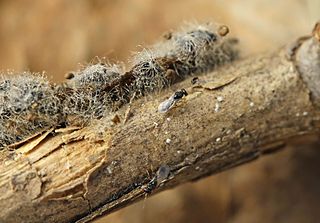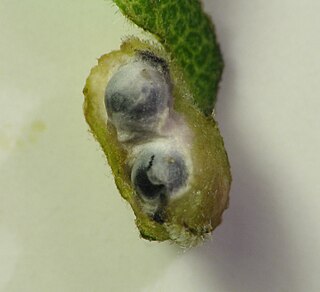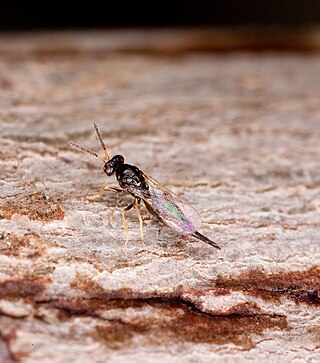
Casuarina, also known as she-oak, Australian pine and native pine, is a genus of flowering plants in the family Casuarinaceae, and is native to Australia, the Indian subcontinent, Southeast Asia, islands of the western Pacific Ocean, and eastern Africa.
The Chinese dormouse or Sichuan dormouse is a species of dormouse found in subalpine mixed forests in northern Sichuan, China, where it is known from Jiuzhaigou and Wanglang Nature Reserves. It is known only from two captured female specimens taken in the Wanglang Natural Reserve, and was first described by Wang Youzhi in 1985 and relisted by Corbet and Hill under a new genus as Chaetocauda sichuanensis. It is currently the only member of the genus Chaetocauda. The two specimens had head and body lengths of 90mm and 91mm and tail lengths of 92mm and 102mm, respectively. They weighed 24.5 and 36.0 g. It is nocturnal and arboreal, nesting in trees around 3 metres above the ground, and was found above an altitude of 2500m above sea level. It is classified as endangered by the IUCN as of the 2004 Red List due to its small, isolated habitat.

The Eulophidae is a large family of hymenopteran insects, with over 4,300 described species in some 300 genera. The family includes the genus Elasmus, which used to be treated as a separate family, "Elasmidae", and is now treated as a subfamily of Eulophidae. These minute insects are challenging to study, as they deteriorate rapidly after death unless extreme care is taken, making identification of most museum specimens difficult. The larvae of very few species feed on plants, but the majority are primary parasitoids on a huge range of arthropods at all stages of development. They are exceptional in that they are one of two hymenopteran families with some species that are known to parasitize thrips. Eulophids are found throughout the world in virtually all habitats.

Caudipteridae is a family of oviraptorosaurian dinosaurs known from the Early Cretaceous of China. Found in the Yixian and Jiufotang Formations, the group existed between 125 and 120 million years ago. Distinguishing characteristics of this group have been indicated as including a unique dagger-shaped pygostyle. In 2015, the group was defined as "the most inclusive clade containing Caudipteryx zoui but not Oviraptor philoceratops and Caenagnathus collinsi".

The genus Cathartes includes medium-sized to large carrion-feeding birds in the New World vulture (Cathartidae) family. The three extant species currently classified in this genus occur widely in the Americas. There is one extinct species known from the Quaternary of Cuba.
Kiggaella is a genus of hymenopteran insects belonging to the family Eulophidae. There is just one described species, Kiggaella oryzae, only known from rice paddies in Karnataka and Kerala states, India.
Afrotroppopsis is a monotypic genus of hymenopteran insects of the family Eulophidae.
Agmostigma is a small genus of hymenopteran insects of the family Eulophidae which contains three species, all described in 1996 by Ubaidillah and LaSalle and so far only recorded from Brunei in northern Borneo.
Baeoentedon is a genus of hymenopteran insects of the family Eulophidae, they are parasitoids of whitefly from the family Aleyrodidae which are found on trees of the genus Ficus. They have been recorded from Australia, China, India, Indonesia and Florida. A fifth species, Baeoentodon farazi, was described from Karnataka, India, in 2017.
Ceranisus is a genus of hymenopteran insects of the family Eulophidae. They are parasitoids of thrips of the order Thysanoptera and may be important in their biological control.
Chouioia is a genus of endoparasitic wasp of the family Eulophidae. Chouioia cunea is considered an important parasite of the fall webworm in China, where the moth is an invasive species.

Colpoclypeus is a genus of hymenopteran insects of the family Eulophidae.
Emersonella is a genus of hymenopteran insects of the family Eulophidae. Several species are known to be phoretic parasitoids of female tortoise beetles, laying their eggs in the eggs of the beetle host.
Eprhopalotus is a genus of hymenopteran insects of the family Eulophidae. Their distribution varies between species but ranges from Costa Rica, Mexico to Texas. There are currently 5 species of Eprhopalotus:

Euplectrus is a genus of hymenopteran insects of the family Eulophidae.

Galeopsomyia is a New World genus of hymenopteran insects of the family Eulophidae. The genus is a hyperparasitoid of other gall-inducing wasps of the genera Eurytoma and Torymus.
Goetheana is a genus of hymenopteran insects of the family Eulophidae.

Horismenus is a genus of hymenopteran insects of the family Eulophidae occurring primarily in the Americas. As of 2015 over 400 species in the genus have been described. Horismenus species are often described as parasitizing other insects.

Leptocybe invasa, the blue gum chalcid wasp or eucalyptus gall wasp, is a chalcid wasp which is the only species in the monotypic genus Leptocybe in the subfamily Tetrastichinae, of the family Eulophidae. It is a gall wasp which causes the formation of galls on a number of species of Eucalyptus, it was described in 2004 after galls were found in river red gums in the Mediterranean and Middle East and has since been found to be a widespread species where its host trees are planted. It is indigenous to Australia.

Tetrastichinae is a subfamily of the chalcid wasp family Eulophidae. It is one of the largest subfamilies of the Eulophidae containing over 100 genera and nearly 3,000 species. The species of the family Tetrastichinae are found in almost any type of terrestrial habitat and have a worldwide distribution, except Antarctica. They show a varied biology and hosts for Tetrastichinae wasps have been identified from over 100 different insect families, across 10 different orders and they have also been recorded as being parasitoids on nematodes, mites and spiders' eggs. Some species are even phytophagous, while others are inquilines and yet others are gall formers.








